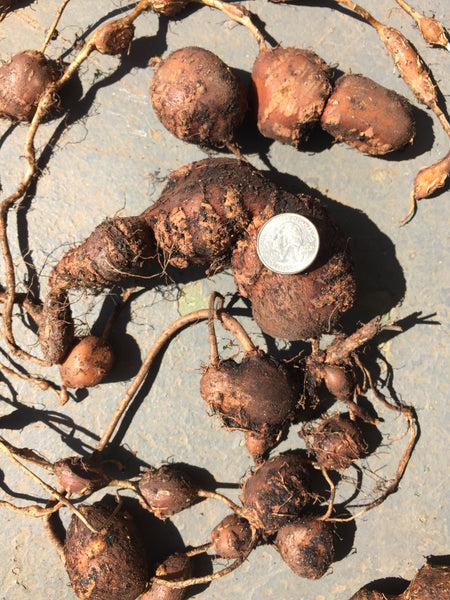Groundnuts (Apios americana) are a vining, nitrogen fixing legume that you don’t even know you need yet! This tuber has been found in indigenous diets from Canada to the Gulf Coast. It is a perennial food crop with edible tubers and podded beans! The beans can be eaten, while the pods are fibrous.
Their flavor and role in the kitchen has been compared to that of potatoes, but with so much more protein! Mashed, smashed, roasted, steamed, or smothered in ketchup- these tubers are the perennial food of the future.
Not only that- their vines grow up to ten feet tall and produce the most enchanted purply/pink flowers that resemble that of a wisteria. Just a food? Think again! This amazing plant is also a gorgeous ornamental, creating the perfect privacy barrier for any porch, window, fence- whatever you can imagine!
In its natural state, it is most often found in moist areas near streams or bodies of water where it can get full sunlight for at least part of the day. However, improved or saved lines respond well to the appropriate cultural conditions.
How To Grow
For best results, grow these tubers in full sun in good, loamy soil. If the soil is not well draining, the plants will grow anyway and the tubers will not rot! Raised beds are desirable as groundnuts tend to spread rapidly. Slightly acidic to neutral soils seems to help with tuber performance.
Tubers may be planted from late winter to late spring, while harvest happens after the first fall frost in order to maximize the growing period. Harvested tubers can be stored for months in a root cellar or cool area, similarly to potatoes. Replant your smallest tubers for next year’s harvest.
Seed tubers should be placed whole (not cut like potatoes) on their sides two to three inches deep and spaced 18 to 24 inches apart. Sprouting may not be uniform.
Weed control can be the most difficult aspect of growing groundnuts as the vines tend to intertwine with whatever it can reach. They can be grown with or without trellising, though trellising may be preferable for this reason. Mulching will also help control weeds.
Insects and diseases found with groundnuts are similar to those of snap peas or lima beans. Voles are also very fond of the tubers.
Techniques and knowledge around growing groundnuts has been fairly limited. If you are able to identify a cultural practice that is effective or beneficial, let your fellow groundnut growers know!

|
Article Written by: Hannah Gibbons |
|
About the Author: Hannah Gibbons, an employee at Sow True Seed since 2020, has nearly a decade of experience in the agricultural industry. Their passion for environmental education and regenerative agriculture has been the cornerstone of their work, aimed at making gardening accessible to all. |



